This article will answer these questions and many more about NRM; What is revenue management process? What is NRM FMCG? What is Revenue Management CPG? How can RGM drive sales?
Let’s talk Net Revenue Management (NRM) (Or Nett Revenue Management, to give it the correct title). Growth is hard. Especially in grocery, particularly with 85% of innovation in Consumer Products failing within three years, according to Nielsen. Plus, according to the Boston Consulting Group, in the past 3 years two-thirds of revenue growth, and an even bigger share of profit growth among the top 50 global fast-moving consumer goods (FMCG) companies, have come from pricing and mix. Not from volume increases.
Many large FMCG companies are turning to Net Revenue Management as a solution. Is it a fad? Is it the holy grail? Or is it simply a build on good category practices? Probably the latter. NRM is also known as revenue management, revenue growth management, yield management, or price & promotion planning.
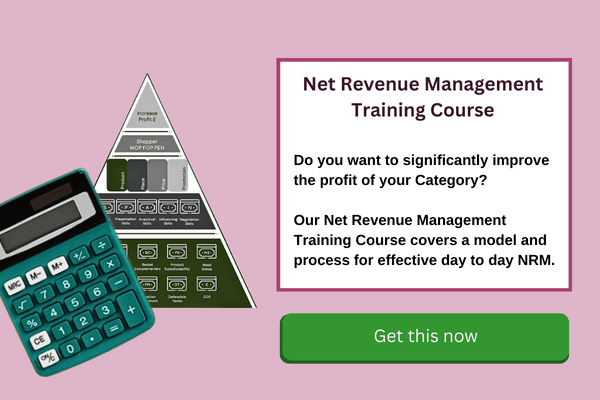
1. What is NRM Net Revenue Management?
According to Wikipedia, the answer is:
‘Revenue management is the application of disciplined analytics that predict consumer behaviour at the micro-market levels and optimise product availability and price to maximise revenue growth.’
In my simple understanding, you might call it, ‘Category Management‘ or some people call it, ‘Revenue Management Optimisation’. Which is the ability to meet a shopper’s needs by managing a group of products that fit a shopper’s need, e.g. I need to wash my clothes, equals the ‘Washing Powder Category’. Let’s look at net revenue management another way by breaking down the words:
- Net is – Remaining after all deductions.
- Revenue is – Income, especially when of an organisation and of a substantial nature.
- Management is – The process of dealing with or controlling things or people.
So, Net Revenue Management is about managing sales and profit. This term has become popular in recent times (See graph below) and is largely considered a data-driven process. Using shopper data to drive decisions. To improve the performance of products, so that sales and profit increase.
If you were to take-away an answer to ‘What is NRM?’, my answer would be:
Optimise Price, Promotions, Range, Placement, and Trade Spend.
The graph below utilises google’s trend tool. This tool shows how many searches there are on google for any given term, over time. For net revenue management, you can see that since 2018 the number of searches has doubled.
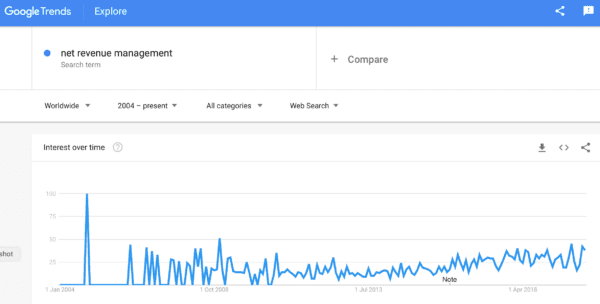
2. How Does Net Revenue Management Work?
In its simplest sense, NRM is about using data to make decisions. This is not new. NRM feels like a build on Category Management because it completely pivots on data. Category Management was meant to use data. NRM absolutely does. It’s about being smarter to increase sales, whilst increasing profits.
As an example, budget airlines would sell very cheap seats because every seat sold, whatever the price, was money in the bank. Better to sell all the seats at an average of £30 each, than 60% of the seats at £45 each. Supermarkets and suppliers adopting NRM are realising that 100% availability is costly. Better to have a higher availability on the products that cannot be substituted, like Tobasco, and less availability on products that can be substituted. For example, if I couldn’t buy Heinz tomato ketchup, I might buy the own label equivalent.
For Grocery, we come back to ‘Optimise Price, Promotions, Range, Placement, and Trade Spend.’ This should be achieved by evaluating what has worked and has not worked in the past. Imagine having a thorough evaluation of each category promotion. The impact on the Supplier, the Supermarket and the Shopper – The 3-legged stool. Not just whether volume increased, but what was the long term effect on the category by promoting – Did shoppers just stockpile and buy no more?
Let’s consider the big picture eutopia of promotions…Knowing how much you spend on promotions each year, and what was the return on investment for the Supermarket, Supplier, and Shopper perspectives. This would be the holy grail!
3. What is NRM in the Airline Industry?
The primary aim of revenue management (RM) is to:
…sell the right product to the right customer at the right time for the right price…
In essence, how ‘badly’ does the customer need the product. This means that the airline is managing the availability of seats, with lead time, and price. All in all, trying to maximise their revenue (sales), in order to maximise their profits. For example, you might be able to buy a cheaper seat if you book in advance, and pay more if you book last minute. Or the reverse can happen, where the airline has many seats remaining at the last minute and sells them cheaply. It’s about selling the right product to the right customer at the right time for the right price.

Yield Management
It all started with BOAC, now British Airways. They experimented with early-bird discounts to stimulate demand. Then the chairman of American Airlines, Robert Crandall, took it one step further. He pioneered yield management. This was done by maximising revenue through analytics-based inventory control. Other industries took note of Crandall’s success with AA’s sales increasing by +14.5%. Namely Marriott hotels. They began using NRM for their 160,000 rooms and by the mid-1990s, had added over $175 million to their sales. And so, the concept began to trend.
NRM in Manufacturing and Retail
In the manufacturing and retail industry, Net Revenue Management is applied differently. Though the principles are the same. Manufacturers and retailers would also use data. This would certainly be shopper data, accompanied by such data sets as epos sales, epos waste, and availability. The challenge is to understand how to meet the shopper’s needs better by using the data. For example, a promotion might be more effective as a ‘Buy 2, Get 3rd Free’ because the penetration is high, and therefore we now want to achieve a higher frequency of purchase (FOP).
4. What is Meant by NRM in the Travel Industry?
The travel industry is no different from the airlines. A need to maximise revenue from a fixed inventory – rooms. The ideal is for a hotel to have maximum occupancy all of the time and for each guest to have paid the maximum price. Yield management, or NRM, is about striving to achieve that ideal. Using data, like previous demand, the hotel can try to maximise their sales by changing their prices to entice guests to choose their hotel.
5. How Do We Calculate Revenue?
Revenue is sales. Sales are the amount of money gained from customers. It is that simple. To calculate the sales for a company, you simply do the following calculation:
Sales = Units Sold x Sales Price
For example, if you are a hotel and want to know your sales for last week – It is the number of rooms sold x the price you sold each room for. Maybe that is 100 rooms sold last week at an average of £50 per room equals £5,000. Your sales for last week were £5,000.
The challenge is to increase this number each week. A hotelier only has 100 rooms, so this is a fixed, and not a variable. Like an airline only has so many seats on a plane. Net Revenue Management aims to use data to increase the average price. For example, the hotelier might sell the first few rooms at £65 per room, and the final rooms at £65 per room. And those ‘in the middle’ at £48 per room.
The average would then be higher than £50.
6. What is Revenue Management Strategy?
A strategy for revenue management is a focus on a particular piece of the category or business. For example, a promotions strategy would be a key focus for a supplier. We often refer to ‘RAPPP’ as the key strategies for any category. Range, Availability, Price, Placement, and Promotions. This is because there are many levers you can pull to maximise sales and profit. Our experience in Category Management suggests that these 4 are the ones that drive the biggest change. The 80:20 of a category.

A promotions strategy would focus on using the data to evaluate previous promotions, in order to achieve a better return on investment. Traditionally, National Account Managers have been poor at evaluating promotions because the ‘noise’ is too great. The noise is the number of variables in a category. From cannibalising other products to the weather, to other category promotions, and much more. This has led to promotional plans that just mimick the previous year.
Our advice is to start with just 3 measures from each of the key perspectives; Shopper, Supermarket, and Supplier. Nine measures will paint a picture that will help to improve the ROI from promotions. Then, we suggest building on these as you build up your experience, and have a thirst to use more data to learn more.
7. What is Revenue Optimisation?
This 2-minute video from Nielsen provides a great answer:
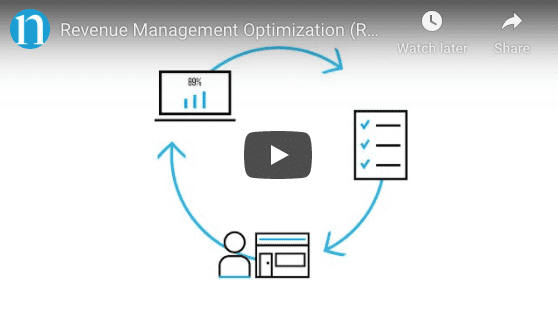
The key takeout is that 72% of trade spend does not break even!
Additional key take-outs from Nielsen’s article on Revenue Management Optimisation.
- Consumer product companies spend extensively on trade promotions—to the tune of $1 trillion each year. The disappointing part is that about 40 per cent of that spending doesn’t drive the desired results.
- After all, companies spend more of their marketing budgets on trade promotion than on anything else. But with so many moving parts involved, it’s not surprising that companies often build a series of disjointed roads rather than a unified highway.
- Strategic planning: Make more confident annual price and promotion strategies based on extensive scenario planning, using forward-looking analytics to drive on-point promotion strategies and execution-oriented sales plans.
- Tactical planning: Deliver execution-oriented sales plans aligned to your greatest opportunities and verified through event-level scenario planning and forward-looking analytics.
- Ongoing retail execution: Monitor trade promotion performance in real-time to maximize retail promotion compliance, product distribution and inventory availability.
- Post-event analytics: Perform comprehensive profit and loss analyses after each event to guide future program decisions.
- Trade spending has doubled over the past 10 years—at the expense of profits—and is now more than twice that of ad spending.
8. What are the Benefits of Net Revenue Management?
The answer is simple. Increased sales equal increased profits. By optimising your sales, you are a better performing business. More profitable. Businesses have been trying to do this since the dawn of time. The angle that NRM brings is the absolute focus on using data to enable a business to be smarter. Whether they are adjusting prices like an airline, or a hotel, or focusing on promotions, like a supermarket supplier. The challenge is not whether to adopt NRM but choosing which strategies to adopt and then focusing on achieving more from less.

9. What Does an NRM Model Look Like?
Below is our Net Revenue Management Model. We call it the ‘NRM Tool Pyramid’. This would be a key model for a Net Revenue Manager.
Increase Profit £
Starting at the top, NRM is all about increasing profits for your business. This is the end game. Next is the shopper.
Shopper WOP FOP PEN
These are the key to achieving increased profits. We can only increase sales, and therefore profits by doing one of 3 things with the shopper:
- WOP: Weight of purchase – Encouraging the Shopper to buy more on each shopping trip. For example, a promotion of ‘Buy 2, and get the 3rd free’.
- FOP: Frequency of purchase – Encouraging the shopper to buy more often. For example, a price reduction in the winter on a product normally bought in the summer, like ice.
- Pen: Penetration – Encouraging more Shoppers to buy the product. For example, a simple recipe on how to use a product that is traditionally beyond the average cook.
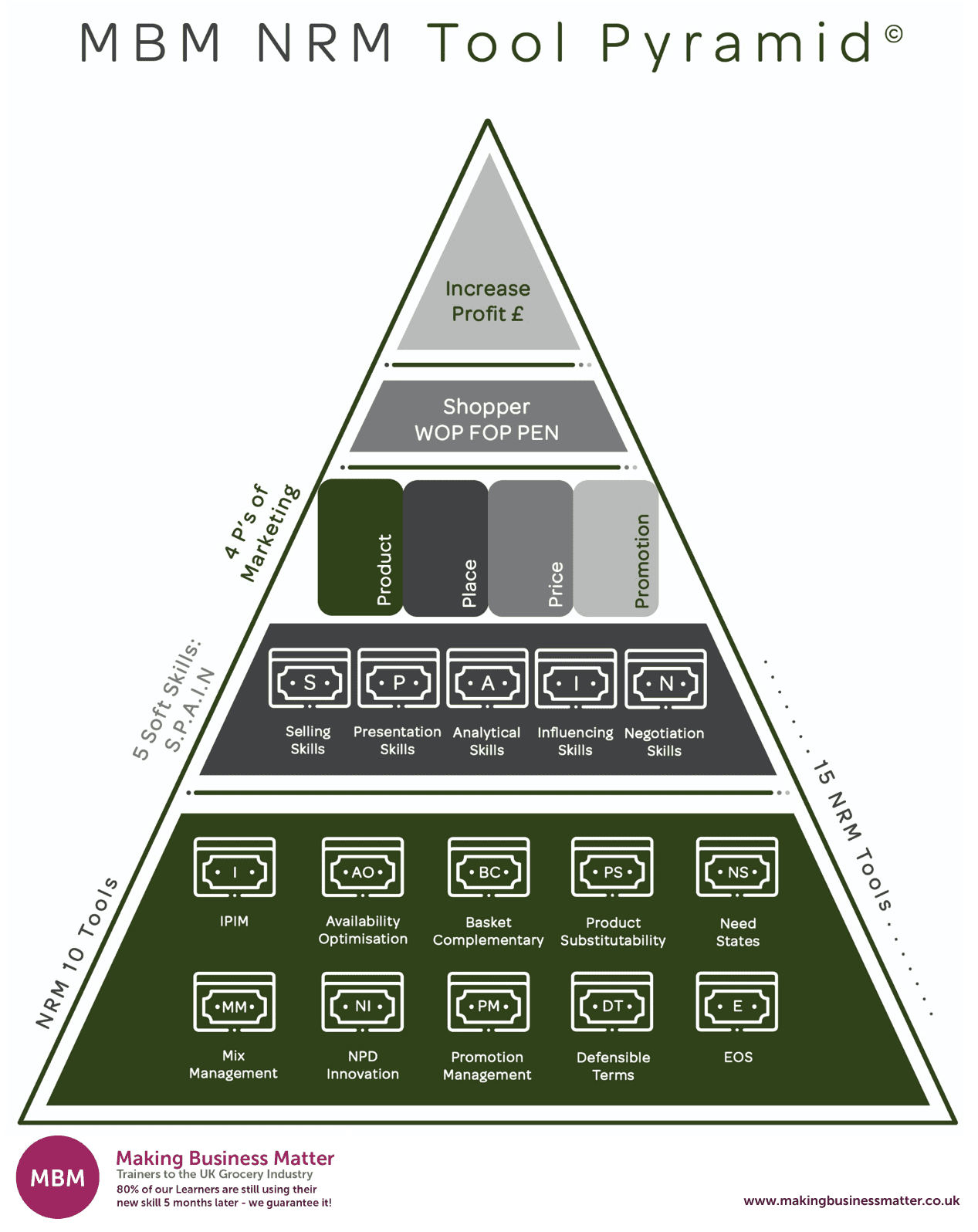
4 P’s of Marketing
The 4 P’s of marketing help us to choose a strategy to focus; Product, Place, Price and Promotion. This might be improved further to be RAPPP; Range, Availability, Price, Placement, and Promotions. Similar. Maybe this term is more easily understood by Category Managers.
S.P.A.I.N.
In the next row, we see ‘SPAIN’. The soft skills are key to making it all happen. Without the ‘people’ element, nothing will happen. As Jack Ma, the Chairman of Alibaba said, ‘We need to focus on things that machines cannot do, like teamwork, and influence’. The key soft skills for managing and implementing Net Revenue Management are:
- Selling Skills – Once we have identified a new product for the category. We need to be able to sell it to the Buyer.
- Presentation Skills – Buying people into our actions is key. Whether they are internal or external.
- Analytical Skills – Knowing what the data is trying to tell us is essential.
- Influencing Skills – Getting people to do what we want them to do is at the heart of NRM. Collaborative working.
- Negotiating Skills – Inevitably we will need to get the best deal.
NRM 10 Tools
Finally, we have our 10 tools for optimising profit. Each tool is a means to understand how to maximise sales, and therefore profit for the category. As an example, knowing which products are substitutable is powerful. This is because achieving 100% availability is costly. If we can maximise the availability of those products that are not substituted, eg. Tobasco, and allow a lower availability on those products that are substituted, we are managing our availability more smartly.
For the other 9 tools, contact us, and we’ll share details of our NRM training course.
10. What is Meant by the Term ‘Margin Waterfall’ in Net Revenue Management FMCG?
The term ‘Margin Waterfall’ refers to where the money is made. The idea is that the profit is made, and then each cost takes a nibble from that margin until you reach the profit before overheads. By understanding the margin waterfall, we can focus on what costs to reduce or optimise, and which areas to increase, like sales.
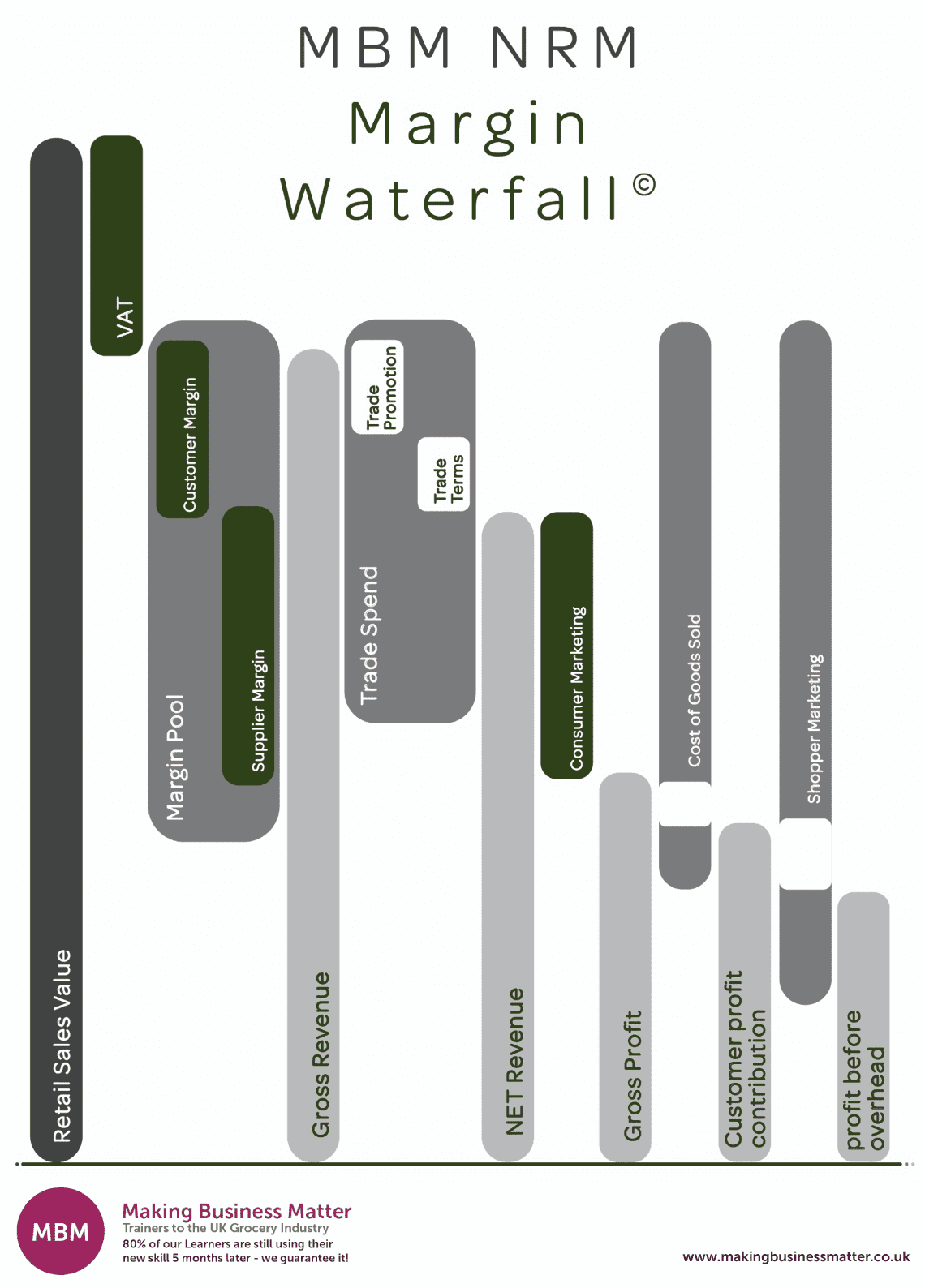
11. How do Companies Fail at Implementing NRM – 10 Mistakes?
‘Net Revenue Management is done by the NRM guys’ – Part one.
NRM is similar to customer service. Whilst companies do have customer service departments, everyone in the company should be ‘in’ customer service. NRM is similar. Everyone needs to understand the part they play in delivering sales and profit with an NRM mindset.
‘Net Revenue Management is done by the NRM guys’ – Part two.
NRM must be led by the top. The leadership meetings need to have an agenda point of NRM.
‘Just increase our prices!’.
Increasing prices will increase sales and profits. Though this comes with two warnings; the first is that we might alienate shoppers, and the second is that price is only one of many levers that can be pulled. The advantage of pulling the price lever is that it is quick and easy to do. Just make sure that it is the right thing for the Shopper, Supermarket, and Supplier, and for the longe term.
‘Treat all store formats the same because that’s easier to do’.
Each store format requires a different approach. This is about managing complexity Vs performance. The ultimate aim is to create an offer for each store. This is not possible. An offer for each format, meeting the specific needs of those shoppers in that format, is better. A convenience store shopper has different reasons for shopping than a large store format shopper. Catering to each of their needs better than the competition is the way to win.
‘Yes, we largely do the same promotions as last year’.
So many promotional programmes are just a copy and paste of last year. The driver behind this is a lack of evaluation. The driver behind no evaluations is that there are too many variables. This leads to promoting ‘what we did last year’ to manage the same highs and lows. For example, we don’t want to stop the bogof in Period 1o because we’ll then be behind last year’. Start with the 9 evaluations metric mentioned above.
‘We have bloody objectives!’.
Yes, most companies and employees do. They’re just not S.M.A.R.T. In our experience, 99% of people have heard of smart, and only 1% adhere to it. Objectives must be specific, measurable, achievable, realistic, and timely. Plus, these smart measures must be shared every 2 weeks in a dashboard.
‘You’re going on this training course Thursday, Pete’.
Sending people on 1-day training courses will achieve zero because it will not change behaviours. To change behaviours we need to replicate driving lessons. Little and often.
‘We need a deck to explain this’.
Your customer will not care that you are implementing an NRM initiative. This has to be about them. Why should they care? What’s in it for them? Get them on-board by sharing what they can get from this.
‘Let’s add x% to everyone’s target because that’s what Net Revenue Management will deliver’.
In the first year, share an expectation that everyone has a debt to pay of £x. Build a recognition scheme around those people. A leaderboard, and incentives, using all carrot and no stick. Include peer-to-peer feedback so that those doing well can hear from their colleagues their admiration.
‘We need more tools’.
Use fewer tools well. There are a limited amount of levers that will make a significant impact on sales and profit. Better to use a few tools well, than lots badly.
12. How can a Business Get Started implementing NRM?
MBM has worked with many businesses in the manufacturing and retail sector. Our training course is taught by very experienced tutors that have been doing this at the coal face for many years. The 7 learning objectives of our training course are:
- Understand what is Net Revenue Management and how to apply it.
- Know how to set a profit-based target, that their NRM activity delivers.
- Understand how to analyse shopper data and turn data into significant sales and profit opportunities.
- Leverage the 4 Ps of Product, Place, Price and Promotions.
- Use the fundamentals of ‘S.P.A.I.N.’ soft skills (Selling, Presentation, Analytical, Influencing & Negotiating).
- Use the 10 tools in the NRM pyramid to achieve the target.
- Know how to evaluate each tool in order to improve the next NRM implementation.
Find Out More About NRM Training for Your Business:
Net Revenue Management in Summary
NRM is about pulling the right levers. Focusing on certain elements of the business and using the data to understand how to optimise that part, e.g. promotions.
You can’t pull all the levers. And some levers will deliver a better return on investment than others. I suggest starting with RAPPP; Range, Availability, Price, Placement, and Promotions. In our experience, the biggest returns come from these 4 areas of a category. These are the levers to pull to increase sales and in turn profit. Or to achieve a better outcome from Net Revenue Management.
To seize two-thirds of your revenue growth, contact us. Or complete the form below.

Additional Resources to Review
Net Revenue Management Unilever: In their 2016 end of year accounts, Unilever talks about Net Revenue Management:

3 key initiatives: net revenue management, organisation and zero-based budgeting.
Diageo Net Revenue Management: They share their presentation on the topic.



